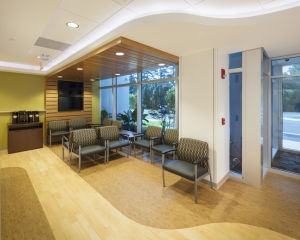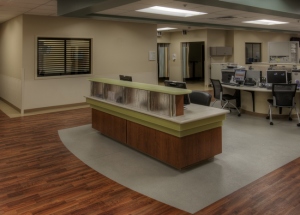Subscribe Now
Aligning Space with Strategy
With recent changes to the healthcare facility landscape, opening more locations no longer translates to financial success. However, in this era of declining reimbursements and expensive construction, facility designs that support efficient processes allow providers to treat more patients in less space.
 How is this possible? Computer simulation modeling can test process improvements and spatial configurations prior to their implementation and quantify the expected results. A new slogan —“Let me show you how this design will enable success” supersedes the old slogan—“Trust me, it will work.”
How is this possible? Computer simulation modeling can test process improvements and spatial configurations prior to their implementation and quantify the expected results. A new slogan —“Let me show you how this design will enable success” supersedes the old slogan—“Trust me, it will work.”
As real estate and design evolve, they increasingly address cultural, behavioral and process factors. Healthcare designers operated in ‘Trust Me’ mode for many years: “Trust me because I’m the expert and have years of experience. It is going to work.” Today’s healthcare providers distrust this logic.
Computer simulation modeling not only shows how the design works, but also how a combination of design changes work together. For example, when forecasting simultaneous changes to five variables—provider processes, technology, staffing mix, patient flow and physical environment—the simulation model provides a minute-by-minute visualization of these variables in aggregate, allowing viewers to evaluate their options.

Tallahassee Memorial Hospital ED, Tallahassee, Florida.
In a facility response to both capital constraints and operational improvements, entrance and waiting spaces are being reduced and may include only half as many waiting chairs as has been the norm. Photo Credit: David Anderson © copyright Krop 2014.
Computer Simulation Modeling to Reduce Space
It is difficult to ask staff to do more with less in the midst of designing a new environment. To encourage buy-in from staff and facility managers on a proposed design, a computer simulation model can validate outcomes, such as shorter patient throughputs or increased staff efficiency. The model demonstrates that changes in procedures and physical space work together to create a highly effective caregiving environment. To illustrate, modern ambulatory waiting areas have five chairs instead of 10 because operational processes function more efficiently. Ten waiting patients indicate a malfunction in the throughput process. Computer simulation models prove to staff that less space can work better than more space.
In today’s capitally constrained environment, computer simulation modeling helps establish staff expectations at an affordable level in the beginning, in lieu of designing everyone’s dream facility and then value engineering the plan to affordable dimensions later. For instance, every physician does not need a private office, and every nurse does not need a dedicated desk. While it is human nature to ask for the maximum amount of space, often less space will suffice. If staff requires additional space, it is typically a marginal increase. Computer simulation modeling can help demonstrate that some expectations are cost-prohibitive and prove the effectiveness of compact work areas.

Via Christi Hospital St. Joseph, Wichita, Kansas.
Utilizing nurse stations in lieu of private nurse offices centralizes all staff and provides space. Technology advancements have changed facility needs. For example, medication distribution that used to require 4-5 nursing stations can now be handled by two stations on a unit by applying barcode technology. Photo credit: © Chauncey Studios.
Some medical staff may have trouble visualizing and adopting different processes after years of using a particular system. Medication distribution that once necessitated four or five nursing stations now requires two stations on a unit due to advancements in barcode technology. Computer simulation modeling demonstrates that bar coding reduces walking distances for staff, increases patient safety and conserves expenses.
Healthcare services are focused on people. Putting forth the required effort in facility design leads to better patient care and improved provider performance. Not only do team members deliver a higher level of service, but they want to come to work in the morning, resulting in reduced staff attrition and turnover.
All change entails risk, but risk management is the business of leaders in every industry. Applying computer simulation modeling to facility design and process change has made aligning space with strategy less of a gamble and more of a science.
Tags: Architecture, Computer Simulation Modeling
Posted December 10, 2014
More Articles:
- State of Industry Examined in ‘Healthcare Reset’ Report
- Cam Twohey Joins Kahler Slater as Associate Principal, Senior Project Architect in Healthcare Market
- Perkins Eastman Welcomes Michael Hess as Principal in New York Studio
- Guerin Children’s Inpatient Pediatric Unit at Cedars-Sinai Provides Interactive, Family Friendly Healing Environment
- Coverings 2024
Apr 22, 2024 – Apr 25, 2024 - Hospital, Outpatient Facilities & Medical Office Buildings Summit
Apr 25, 2024 – Apr 25, 2024 - CxA Workshop & Exam
Apr 29, 2024 – Apr 30, 2024 - EMP Seminar & Exam at CxEnergy 2024
Apr 29, 2024 – Apr 30, 2024 - CxEnergy
Apr 29, 2024 – May 2, 2024 - PHCC West 2024
Apr 29, 2024 – May 2, 2024 - Lean in Design Forum 2024
May 1, 2024 – May 2, 2024










